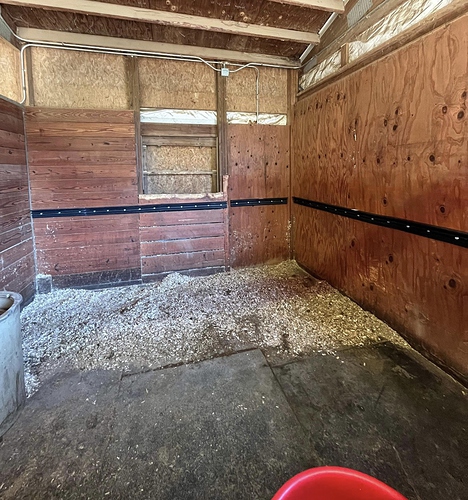One of my horses has recently gotten himself cast a couple times up against the drylot fence that’s made of continuous pipe. The bottom pipe is a foot off the ground. So far he’s been able to get himself up on his own. Before his luck runs out I’m looking for ideas what might work that I can put down at ground level to help him push off on if he gets stuck again. The dirt in the drylot is too soft to make into a bank. Would a wood plank be a good idea? Any suggestions would be appreciated.
We anticipated this issue when getting a pipe panel pen ready for a foal, with maybe slightly less space at the bottom as you have. What we ended up doing was running pressure-treated 2x12s around the bottom of the pen to make a solid “bumper”. We attached them with pipe clamps and dug a small trench before we set them so there’d be no space at the bottom.
There are those anti-roll surcingles. They prevent horse fully rolling onto the spine to turn over if he is rolling and gets legs on fence side. But he may be laying down with legs sticking out under fence.
Boards along bottom edge sound good, if he can’t get hooves under or thru any holes around the board. Keep something on the pipe fence to cut him loose if needed!
electric fence tape will normally keep a horse away from a fence, charged or not as long as the horse has encountered an electric before the horse will respect the tape.
I would be cautious about putting wood up against the fence. Best case, the horse continues to cast up against that and it doesn’t solve the problem. Worst case, he struggles and kicks a hoof through the wood, creating a whole new risk of injury.
Could you run hot wire along an inner perimeter to keep him off the pipe fence entirely?
Attach rubber mats to stall sides (you could do this a couple of ways including plywood with a thick rubber mat over the plywood). Then use anti-cast guards or a piece of wood as a guard for the horse to be able to push off of.
Anticast guards:

We line the interior of our pipe stalls with wood. You can just make a bumper below the lowest pipe, go halfway up, line the whole wall, etc.
A couple stalls are lined with woven no-climb wire… obviously woven small enough that hooves can’t get stuck. That would probably be my move if I was going to line a whole dry lot.
I think the OP is talking about a turn out situation, not a stall. They call it a dry lot fence.
Treat the horse for a few days with one of the fast-acting ulcer coating drugs. I will bet horse stops casting himself. If so, go ahead with full treatment of choice. If not, you’re only out a few days of treatment.
Seriously, purposeful casting is a sign of ulcers and not necessarily a sign you need to change your set up.
How do ant cast strips mounted that high up the wall work? They’re supposed to help a horse grip the wall with its hooves when it’s lying down 
The strips themselves are mounted whatever height the person needs. For larger horses, the height can be larger. For smaller horses, the height is lower. They just need to be able to push off the strip to become uncast.
Ding ding ding. This was my horse to a T the first winter I had him. He cast himself three or four times in about an 8 week span. Turned out to be severe ulcers. He has not cast himself (knock on wood) since we treated him for the ulcers.
I bought the Up-Right Anti-Cast strips for peace of mind. The manufacturer instructions include installation height recommendations based on the height of the horse. Typically when my guy got cast, he would be rolled almost onto his back against the wall with his legs straight up in the air. They need to be up fairly high for a horse to push off of in that position.
Classic “my belly hurts” pose. Glad you got him treated 
3 or 4 times that you witnessed. Oftentimes, horses that purposely cast themselves for ulcer issues are remarkably adept at un-casting themselves. I worked with one yearling who would put himself upside down and get himself back on his feet no problem.
This was 20 some years ago.
Owners: “He does this several times a day.”
Me: “And he just stands up again after doing it?”
Owners: “yes. We tried to go in to help him but he is too fast and just gets up. He’s not actually stuck!”
Me: “Call. The. Vet. Now.”
Colt got treated and never ever turned himself upside down again.
I have never again thought about horses getting cast the way I used to before that incident.
Yup. We always thought it was odd how calm he seemed while waiting for us to get him “un-stuck”. In hindsight, it was a glaring sign that this was a recurring behavior that no longer caused him to panic. He was diagnosed about 4 months after I bought him. I got in touch with a leaser who had him for the 6 months prior to the sale - she said he had habitually cast himself while he was there but was never evaluated or treated for ulcers.
Poor dude likely had them in some shape or form long before I knew him, and learned to “invert himself” to relieve the discomfort.
Aha! I didn’t know that!
Yup. Classic colic symptom in young foals, too. Foals aren’t supposed to lay on their back.

